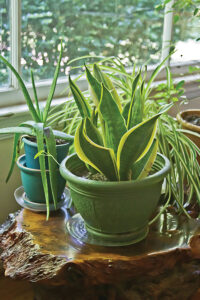“Look around
Leaves are brown
And the sky
Is a hazy shade of winter.”
—Simon & Garfunkel
Autumn’s glorious displays of reds, yellows, and oranges have naturally yielded to the dispiriting winter palette of muted monochromes: browns, greys, and oatmeals. The connection between winter’s shortened daylight hours and seasonal affective disorder has been recognized for some time now, but there’s a lesser-known winter-month correlation between houseplants and better overall health that needs publicizing.
“It’s a fact: During the winter, the air in your home is regularly more polluted than the air outside.
Its well-caulked windows and insulated walls successfully resist any exchange of air, and it thus becomes a musty, germ-laden incubator. Luckily, an easy remedy is available; many common houseplants can clean and improve the quality of indoor air. A couple of decades ago, NASA investigated whether or not houseplants could purify the air in space facilities. They discovered that many could indeed filter out 87 percent of volatile organic compounds (VOCs), as well as other contaminants.
For example, the snake plant is one of the best for filtering out formaldehyde, which is common in cleaning products, tissues, and personal care products. The peace lily cleans indoor air of many environmental impurities. And the red-edged dracaena removes xylene, trichloroethylene, and formaldehyde, which can be brought in through lacquers, varnishes, and dry-cleaned clothing.

Other houseplants that cleanse indoor air include aloe vera, spider plant, English ivy, Chinese evergreen, jade plant, and golden pothos.

“A good rule of thumb is to use at least one houseplant per 100 square feet of indoor space.
And houseplants can additionally purify the air by pulling contaminants into your potting soil, where root-zone microorganisms convert VOCs into food for the plant.
All these are tangible improvements, but perhaps just as important are the intangibles. Houseplants have the capacity to soothe frayed nerves, slow the breath, relax the muscles, quiet the mind, and enhance the quality of your life.
Green is a cool color and is thus thought to calm, heal, and refresh. It helps to relieve inflammation and lower blood pressure.
By releasing some 97 percent of the water they take in as moisture vapor, houseplants increase oxygen levels and humidify indoor air, which means fewer vexing episodes of dry skin and fewer respiratory illnesses, including colds, dry coughs, and sore throats.
The humble houseplant not only alleviates many seasonal ailments but introduces a welcome pop of green—the harbinger color of spring—to battle those bleak winter blues.—By Kat Schneider
